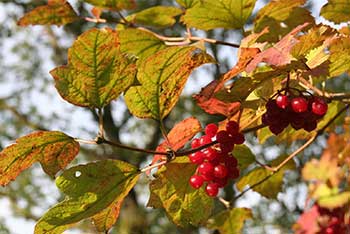Autumn: looking forward to a gorgeous few weeks
For today’s blog I decided to headed up Willesley Drive to see how some of the trees I looked at last week had changed. We’ve had a few cold nights so I was expecting quite a bit more colour and that was certainly the case.

Close to the old craft shelter (you'll see this marked on the map in your Autumn Guide), a mature hickory stood out from the woodland behind. All over the arboretum, the bright yellow leaves of the hickories have lit up during the week.

To the south of the drive, just before the entrance to Sand Earth, the young paper-bark maple (Acer griseum) was just beginning to turn its usual bright red. This is a truly all-year-round species thanks to its rusty red flaking bark that looks particularly fine on a sunny late autumn or winter’s day.

I took a dip into Sand Earth to look at some of its unusual species. Almost immediately I was confronted by the spectacular sight of a cherry birch (Betula lenta) in full autumn colour with the sun streaming through the foliage. I later saw others in the link and all of them were at about the same stage.

Further into Sand Earth I spent a few minutes trying to photograph a young golden larch (Pseudolarix amabilis) as it was buffeted by the strong breeze. Tripods are great things but not much use when the branches are waving around – excuse the shake! This rare deciduous conifer from China really lives up to its name with its whorls of golden needles.

Tree work around the arboretum produces a lot of woodchip and the tree team use it to mulch both young and mature trees. As well as suppressing weed growth and protecting surface roots, it creates a nutrient source for a wide variety of fungi. After damp weather (and we’ve had plenty of that) these mulched circles often become fungal ‘carpets’. I took this picture of young puff balls just about ready to waft their spores on the breeze.

Crossing into Palmer Ride I came upon a young maple showing spectacular colour. Acer diabolicum gets its strange name from the fact that the winged fruit have little horn projections - hence the devil or diabolical reference. Trees of this species are either male or female (not both) but in any case this individual is too young to fruit. I have seen and collected it in Japan in forests around Mount Fuji where its colour is as intense as any of the maples.

From Palmer Ride I took a short cut back through the coppice woodland. The native shrubs including spindle and wild dogwood were putting on quite a show of their own but the thing that really caught my eye were the bright ruby berries on the guelder roses.

Just before reaching the valley bottom gate on the edge of the Downs, the dank mossy trunk of an old oak can be seen providing a home and source of nutrition for sulphur tuft fungus. This species takes advantage of dead wood and can provide a useful clue to decay in the trunks of old trees, particularly where they are close to busy paths or buildings. This one is in a quiet location and can go on providing a valuable habitat for fungi and a host of other deadwood species.

So where are we on the colour ‘thermometer’? It’s not at peak intensity yet but is certainly advanced enough to make a trip well worth while. For the next two weeks it’s going to be truly gorgeous. Let’s hope for more good weekends!
Useful links
Keep an eye on autumn colour and share your images of this autumn at Westonbirt on our Facebook page
